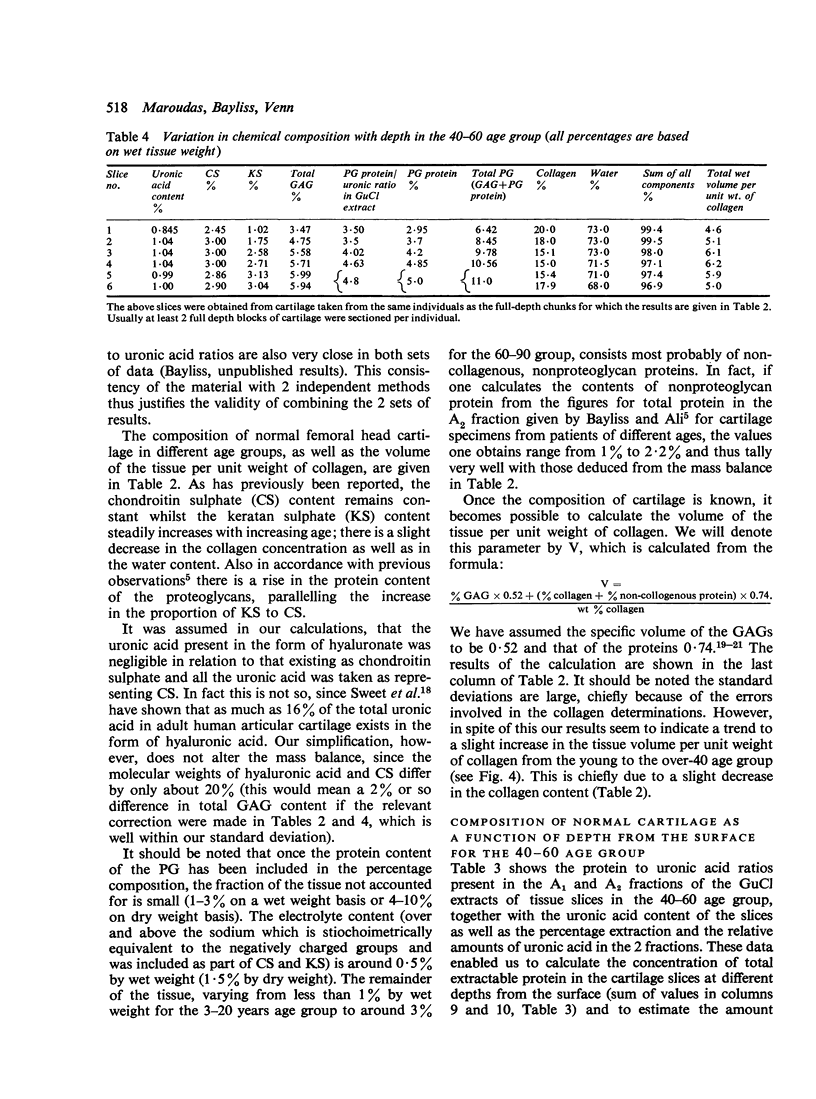Abstract
This report continues our previous studies on the composition and swelling of articular cartilage. When the protein part of the proteoglycan moiety has been taken into consideration, there is no longer a large fraction of the tissue which is not accounted for. In fact, the collagen, proteoglycans, and free electrolyte represent over 92% of the dry weight of adult femoral head cartilage, the remainder consisting most probably of other glycoproteins. Once the composition of cartilage had been well defined, it was possible to calculate the overall wet volume of tissue per unit weight of collagen for both normal and osteoarthritic cartilage. This is an important parameter, as it constitutes a direct measure of the extensibility of the collagen network. By determining the fixed charge density profile close to the articular surface, we have also been able to estimate the swelling pressure due to the proteoglycans in this region of the tissue, and to show that there is a gentle grading of osmotic stresses.
Full text
PDF









Selected References
These references are in PubMed. This may not be the complete list of references from this article.
- BITTER T., MUIR H. M. A modified uronic acid carbazole reaction. Anal Biochem. 1962 Oct;4:330–334. doi: 10.1016/0003-2697(62)90095-7. [DOI] [PubMed] [Google Scholar]
- Bayliss M. T., Ali S. Y. Age-related changes in the composition and structure of human articular-cartilage proteoglycans. Biochem J. 1978 Dec 15;176(3):683–693. doi: 10.1042/bj1760683. [DOI] [PMC free article] [PubMed] [Google Scholar]
- Byers P. D., Maroudase A., Oztop F., Stockwell R. A., Venn M. F. Histological and biochemical studies on cartilage from osteoarthrotic femoral heads with special reference to surface characteristics. Connect Tissue Res. 1977;5(1):41–49. doi: 10.3109/03008207709152611. [DOI] [PubMed] [Google Scholar]
- Elson L. A., Morgan W. T. A colorimetric method for the determination of glucosamine and chondrosamine. Biochem J. 1933;27(6):1824–1828. doi: 10.1042/bj0271824. [DOI] [PMC free article] [PubMed] [Google Scholar]
- GRANT R. A. ESTIMATION OF HYDROXYPROLINE BY THE AUTOANALYSER. J Clin Pathol. 1964 Nov;17:685–686. doi: 10.1136/jcp.17.6.685. [DOI] [PMC free article] [PubMed] [Google Scholar]
- Hjertquist S. O., Lemperg R. Studies of autologous diced costal cartilage transplant. 3. With special regard to glycosaminoglycans, hydroxyproline, calcium and 35S-sulphate incorporation in vitro after intramuscular implantation. Acta Soc Med Ups. 1967;72(3):173–198. [PubMed] [Google Scholar]
- Lipshitz H., Etheredge R., 3rd, Glimcher M. J. Changes in the hexosamine content and swelling ratio of articular cartilage as functions of depth from the surface. J Bone Joint Surg Am. 1976 Dec;58(8):1149–1153. [PubMed] [Google Scholar]
- Maroudas A. I. Balance between swelling pressure and collagen tension in normal and degenerate cartilage. Nature. 1976 Apr 29;260(5554):808–809. doi: 10.1038/260808a0. [DOI] [PubMed] [Google Scholar]
- Maroudas A., Evans H., Almeida L. Cartilage of the hip joint. Topographical variation of glycosaminoglycan content in normal and fibrillated tissue. Ann Rheum Dis. 1973 Jan;32(1):1–9. doi: 10.1136/ard.32.1.1. [DOI] [PMC free article] [PubMed] [Google Scholar]
- Maroudas A., Muir H., Wingham J. The correlation of fixed negative charge with glycosaminoglycan content of human articular cartilage. Biochim Biophys Acta. 1969 May 6;177(3):492–500. doi: 10.1016/0304-4165(69)90311-0. [DOI] [PubMed] [Google Scholar]
- Maroudas A., Thomas H. A simple physicochemical micromethod for determining fixed anionic groups in connective tissue. Biochim Biophys Acta. 1970 Jul 21;215(1):214–216. [PubMed] [Google Scholar]
- Maroudas A., Venn M. Chemical composition and swelling of normal and osteoarthrotic femoral head cartilage. II. Swelling. Ann Rheum Dis. 1977 Oct;36(5):399–406. doi: 10.1136/ard.36.5.399. [DOI] [PMC free article] [PubMed] [Google Scholar]
- McCall J. G. Load-deformation studies of articular cartilage. J Anat. 1969 Jul;105(Pt 1):212–214. [PubMed] [Google Scholar]
- Noda H. Partial specific volume of collagen. J Biochem. 1972 Apr;71(4):699–703. [PubMed] [Google Scholar]
- STEGEMANN H. Mikrobestimmung von Hydroxyprolin mit Chloramin-T und p-Dimethylaminobenzaldehyd. Hoppe Seylers Z Physiol Chem. 1958;311(1-3):41–45. [PubMed] [Google Scholar]
- Sweet M. B., Thonar E. J., Immelman A. R., Solomon L. Biochemical changes in progressive osteoarthrosis. Ann Rheum Dis. 1977 Oct;36(5):387–398. doi: 10.1136/ard.36.5.387. [DOI] [PMC free article] [PubMed] [Google Scholar]
- Venn M. F. Variation of chemical composition with age in human femoral head cartilage. Ann Rheum Dis. 1978 Apr;37(2):168–174. doi: 10.1136/ard.37.2.168. [DOI] [PMC free article] [PubMed] [Google Scholar]
- Venn M., Maroudas A. Chemical composition and swelling of normal and osteoarthrotic femoral head cartilage. I. Chemical composition. Ann Rheum Dis. 1977 Apr;36(2):121–129. doi: 10.1136/ard.36.2.121. [DOI] [PMC free article] [PubMed] [Google Scholar]
- von Berlepsch K. Two automated procedures for determination of uronic acid in acid glycosaminoglycans. Anal Biochem. 1969 Mar;27(3):424–432. doi: 10.1016/0003-2697(69)90056-6. [DOI] [PubMed] [Google Scholar]


